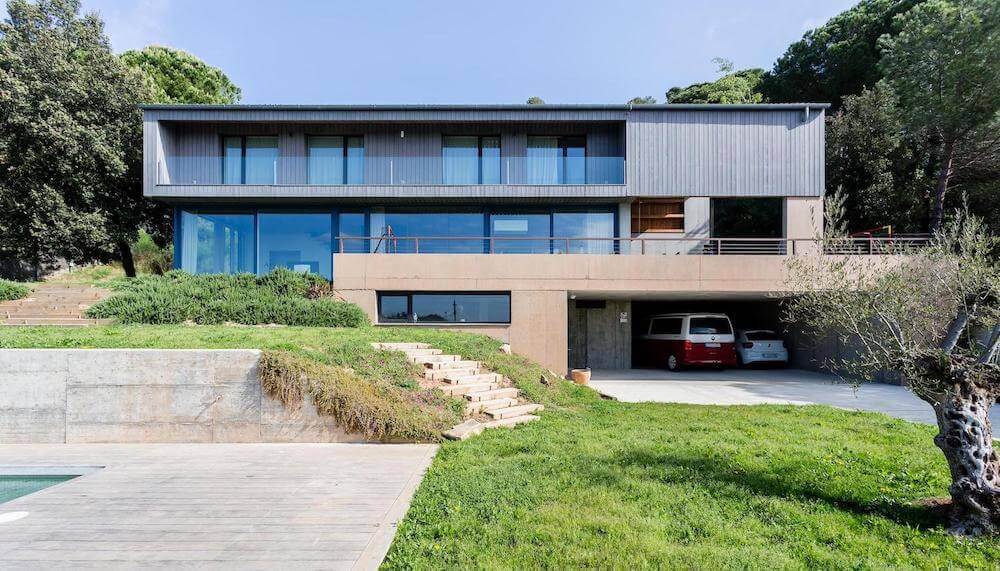
Passivhaus Girona
Bioclimatic architecture and construction focused on energy efficiency are becoming ever more prominent. This stunning 180m2 home has been officially certified as a Passivhaus. Designed by Tigges Architekt and Energiehaus Arquitectos, with Spanish Loxone Partner Progetic Sustainable Projects working alongside them to incorporate home automation.
This home was designed with clear energy efficiency objectives right from the very start of the project. The architects knew that they wanted to meet the requirements to make this a Passivhaus and thus had to consider a plethora of things such as thermal insulation, air sealing, air renewal and management of renewable energy – just to name a few. They also took the local resources and weather conditions into account during the planning stage.

Maximum energy efficiency
In this property, the ventilation, air conditioning, solar panel and blinds all work together to ensure maximum energy efficiency. Loxone intelligently integrates all of these components to create a harmonious ecosystem.
The ventilation and air renewal on this project are done via a Zehnder dual flow system which the Loxone Miniserver then ties in with the heating and cooling systems as well as the energy generated from the solar panels to optimise the energy management.
The goal: to reduce energy consumption whilst maximising comfort
In a country like Spain where they are blessed with (slightly) warmer weather than we are here in the UK, air conditioning tends to be one of the biggest consumers of energy in a typical Spanish household. However, as this Passivhaus is so well designed it has far less of a need for air con. The biggest energy cost in this property is, in fact, the hot water tank. However, the designers of the home anticipated this and turned to automation to manage this more efficiently.
The solar energy generated by the Passivhaus is first and foremost used for everyday power consumption – large and small appliances, lighting, etc. However, if there happens to be any surplus energy left over then that will be used to heat the water.
The power of the resistance is modulated through a voltage regulator, since the production of energy through the solar panels is variable, as is the consumption of electricity and consequently, the surplus.

In the warmer months, the solar energy generated
greatly exceeds the typical demand. In May 2018, for
example, 774 kWh was generated by the panels.
Between May and September, the average monthly consumption
of energy to heat the hot water tanks is 147 kWh.
This means, during the hottest months of the year, the
surplus of solar energy far exceeds the demand of
the hot water tank – ultimately heating the water for free.

Blind control is crucial
Considering the emphasis placed on the specific design of the building, the insulation and the intelligent system in place to manage the solar power, it would be counterintuitive to not control the blinds.
The house has ventilation throughout to help keep rooms cool. However, if sunlight is simply allowed to penetrate directly into the home the ventilation will be fighting against the solar gains. This will result in the system having to work harder to cool the room hence using more energy and making the home less energy efficient.
That’s where Loxone comes in. The venetian blinds are intelligently lowered in order to mitigate solar gains when a room is trying to be cooled and, when a room needs to be heated, they will raise in an attempt to help the heating system out.

Automation is the perfect ally
Automation is perfect for a Passivhaus. The automated lighting means that lights will never be left on by mistake, the control of the windows means that the homeowners will always be able to see their status and having energy usage statistics to hand means that data can be analysed to see if any further savings can be made.
The property also includes a Loxone Intercom, equipped with a remote connection, as well as an integrated access control system which uses fingerprint recognition. This is all controllable directly from within the Loxone app which means that the whole home can always be controlled on-the-go from just one app.
Automation
is the perfect ally
Automation is perfect for a Passivhaus. The automated lighting means that lights will never be left on by mistake, the control of the windows means that the homeowners will always be able to see their status and having energy usage statistics to hand means that data can be analysed to see if any further savings can be made.
The property also includes a Loxone Intercom, equipped with a remote connection, as well as an integrated access control system which uses fingerprint recognition. This is all controllable directly from within the Loxone app which means that the whole home can always be controlled on-the-go from just one app.

Loxone & Passivhaus
The combination of the Loxone system, the Passivhaus standard and the renewable energy generated on-site through the solar panels means that the demands of this building are met with very little need for external energy. The overwhelming majority of energy this building requires is generated from renewable sources.
Interested in Loxone?
Whether you want Loxone installed or you want to start offering your customers Loxone, speak to us about making that happen.



